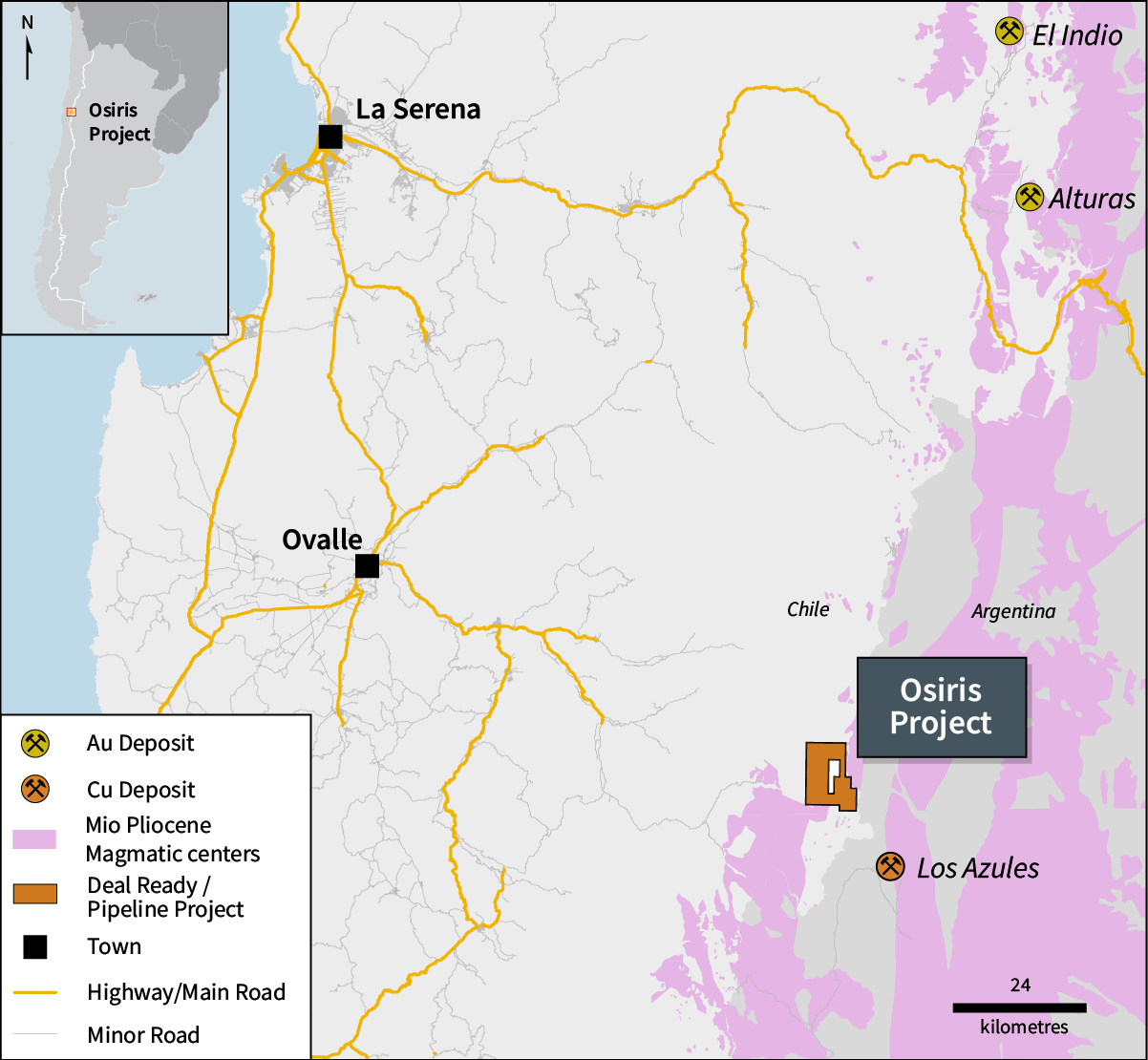Mirasol Resources recently released the exploration results on its wholly-owned Osiris Cu project, situated within Chile’s fertile Miocene belt which is host to more than a few prominent advanced projects such as Los Azules, El Pachon, Altar and Pelambres, among others.
 Osiris project location map. Image Credit: Mirasol Resources.
Osiris project location map. Image Credit: Mirasol Resources.
Mirasol staked Osiris through its project generation program. Osiris comprises about 10,000 ha of exploration claims. The comprehensive surface exploration activities of Mirasol have demarcated two drill-ready concealed porphyry Cu-Mo-(Au) targets.
We are pleased to introduce a new high-quality Cu project in our portfolio, with multiple drill targets. Our preliminary exploration program, which included geological mapping, geochemical sampling, and alteration analysis, has defined prospective targets at Osiris that require drill testing. A search for a partner has been initiated.
Tim Heenan, President, Mirasol
At the geographical level, Osiris is situated within the northern extension of the Southern Miocene porphyry belt and the southern extension of the Miocene Age El Indio high sulfidation epithermal belt, both of which are rich regions in Argentina and Chile.
The Osiris mineralization seems to be controlled by the same prominent northwest striking lineament, an important regional characteristic which also controlled the positioning of the late Miocene Los Azules, an advanced-stage porphyry Cu project (McEwen Mining Inc.— Indicated Resources: 10.2 B lbs at 0.48% Cu and 1.7 Moz at 0.06 g/t Au) situated about 17 km to the southeast.
Osiris, at a project scale, is defined by Paleozoic biotite migmatites and weakly foliated diorite lithologies, which have been cross-cut by Carboniferous-Permian-Triassic intrusives and a number of diorite dykes.
Mineralization is inferred to be related to Miocene aged (13.7 Ma) diorite to rhyolite porphyritic intrusives and structurally controlled magmatic-hydrothermal breccias related with north-northwest and west-northwest regional structures. The hardy magmatism, multi-phase porphyritic intrusives along with the observed structural preparation is said to be favorable for porphyry Cu-Mo-(Au) mineralization.
Cu-Mo-(Au) rock chip geochemistry and alteration spectral investigation have characterized two targets, at the Filo Gordito and Northern Osiris, with Cu mineralization appearing as supergene oxides formed from primary chalcopyrite. Bordering these two targets, geochemical surveys have also established epithermal polymetallic Ag-As-Sb-Te-Bi-Pb±Au anomalies.
Furthermore, on Filo Gordito target’s southeast region, a large 3 x 2 km phyllic alteration footprint influences porphyritic units and intrusive breccias. The intrusive breccia has robust quartz-sericite alteration, which is cut by quartz sericite veins (D-style porphyry veins).
This phyllic alteration, locally presenting an alunite overprint, is said to be characteristic of a porphyry environment and may signify the mid-upper levels of the system and vectors to possibly higher Cu-Au grades within the deeper and underlying potassic zone.
Mirasol is now looking for an exploration partner to progress and drill test this favorable project.